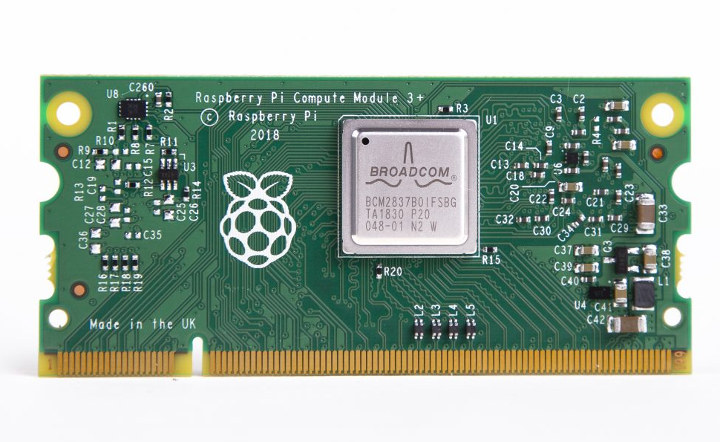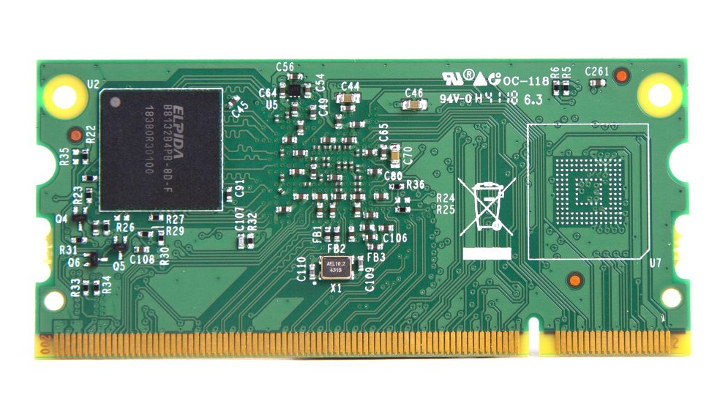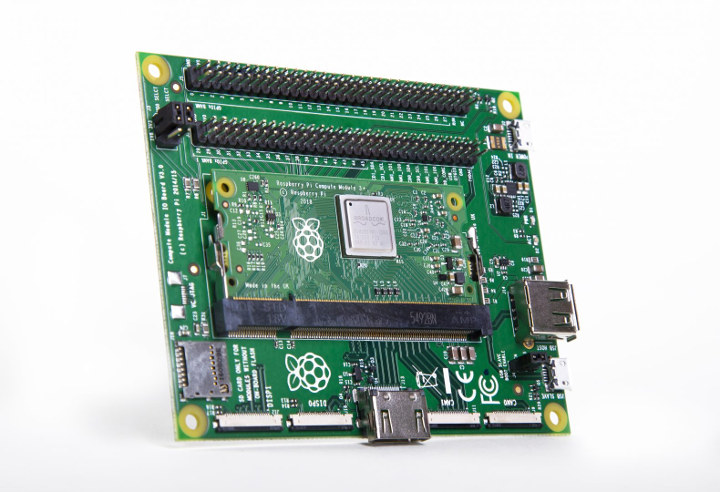Raspberry Pi 3 Compute Modules CM3 and CM3L launched about two years ago based on Broadcom BCM2837 quad core processor found in Raspberry Pi 3 board. Last year, the Raspberry Pi Foundation introduced Raspberry Pi 3B+ board with a slightly faster Broadcom BCM2837B0 processor, Gigabit Ethernet, and WiFi 802.11ac.
So it would have made sense for the foundation to provide an upgrade to their CM3 compute modules with Broadcom BCM2837B0 processor, and that’s exactly what they’ve done with the launch of Raspberry Pi Compute Module 3+ for $25 and up.

There are four variants of Raspberry Pi Compute Module 3+ with different storage options and sharing the following specifications:
- SoC – Broadcom BCM2837B0 quad core Cortex A53 processor @ 1.2 GHz with Videocore IV GPU
- System Memory – 1GB LPDDR2 SDRAM
- Storage
- CM3+/Lite – SD card signals through SO-DIMM connector
- CM3+/8GB – 8GB eMMC flash
- CM3+/16 GB – 16GB eMMC flash
- CM3+/32 GB – 32GB eMMC flash
- 200-pin edge connector with:
- 48x GPIO
- 2x I2C, 2x SPI, 2x UART
- 2x SD/SDIO, 1x NAND interface (SMI)
- 1x HDMI 1.3a
- 1x USB 2.0 HOST/OTG
- 1x DPI (Parallel RGB Display)
- 1x 4-lane CSI Camera Interface (up to 1Gbps per lane), 1x 2-lane CSI Camera Interface (up to 1Gbps per lane)
- 1x 4-lane DSI Display Interface (up to 1Gbps per lane), 1x 2-lane DSI Display Interface (up to 1Gbps per lane)
- Power Supply – VBAT (2.5V to 5.0V) for BCM2837 processor core, 3.3V for PHYs, UI and eMMC flash, 1.8V for PHYs, IO, and SDRAM, VDAC (2.8V typ.) for video composite DAC, GPIO0-27_VREF & GPIO28-45_VREF (1.8 to 3.3V) for the two GPIO banks.
- Dimensions – 67.6 x 31 mm; compliant with JEDEC MO-224 mechanical specification used in DDR2 SO-DIMM memory module
- Temperature Range – -20 to +70 degrees Celsius

While Broadcom BCM2837B0 processor can be clocked at up to 1.4 GHz on the board itself, it is limited to 1.2 GHz on the Compute Module 3+, just like for BCM2837 processor found in CM3 and CM3L, due to power-supply limitations. Having said that, the CM3+ has better thermal behavior under load thanks to the processor and a new & improved PCB thermal design, so getting BCM2837B0 will provide better performance under some scenarios even if it is clocked at the same frequency.
The new modules also offer more storage space from 8GB to 32GB eMMC flash against only 4GB in the previous compute module. Apart from the new processor and storage options, CM3+ is a dropping replacing with CM3 and CM3 Lite modules. The only physical difference is “a small increase in z-height”. The software support will be the same, but a different firmware is required for the new modules.

The foundation also launched the CM3+ development kit based on the existing carrier board (Compute Module IO board), a CM3+/32GB compute module, a CM3+/Lite compute module, camera and display adapters, jumper wires, and a programming cable.
Pricing for the compute modules starts at $25 for CM3+ Lite, and goes up to $30, $35, and $40 for respectively CM3+ 8GB, 16GB and 32GB, all of which you can find on Element14 / Farnell / Newark, and other distributors, although without any stock at the time of writing. I could not find price for the CM3+ development kit right now. More details about CM3+ compute modules, including the datasheet, can be found on the product page.

Jean-Luc started CNX Software in 2010 as a part-time endeavor, before quitting his job as a software engineering manager, and starting to write daily news, and reviews full time later in 2011.
Support CNX Software! Donate via cryptocurrencies, become a Patron on Patreon, or purchase goods on Amazon or Aliexpress




